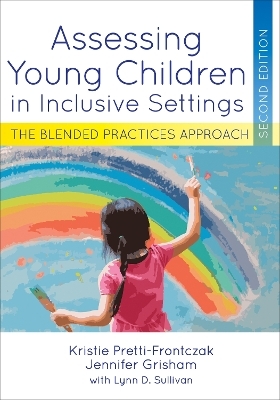
Assessing Young Children in Inclusive Settings
Brookes Publishing Co (Verlag)
978-1-68125-599-6 (ISBN)
Meaningful, authentic assessment practices are one key to the success of early childhood inclusion. Prepare current and future teachers with the second edition of this comprehensive textbook, an in‐depth guide to the how and the why of high‐quality assessment in the context of inclusive early childhood settings.Updated with new contributors and coverage of timely new topics, this book takes a blended approach to assessment, combining the latest recommended practices from early childhood education and early childhood special education. Well‐known experts Kristie Pretti‐Frontczak and Jennifer Grisham have developed this text to align with Division for Early Childhood Recommended Practices on assessment. Educators will learn how to select and use assessment instruments, conduct authentic assessment during daily activities and routines, collaborate with families and other team members, master the challenges of kindergarten assessment, conduct eligibility assessments, use assessment to inform program planning and monitor progress, and more.
Ideal for both undergraduate and graduate courses and personnel preparation programs, this comprehensive text gives teachers the knowledge and tools they need to implement high‐quality assessment and reap its benefits: inclusive, family‐centered programming that improves outcomes for all children.
WHATS NEW:
New section on considerations for special populations: dual language learners, children in kindergarten, and children who have severe and multiple disabilities
Increased focus on educational equity throughout the book
New and expanded coverage of important themes and topics, including authenticity, collaborative partnerships, and data‐based decision making
New invited contributors who are experts in the field and advocates for early childhood inclusion
More practical materials, including new and extended case studies, a revised Curriculum‐Based Assessment Rating Rubric and glossary, and a list of recommended practices
Overview of revised versions of commonly used curriculum‐based assessments, including AEPS‐3, COR Advantage, and Work Sampling System
Companion materials for faculty, including PowerPoints with links to activities and resources
Foreword
Acknowledgements
Dedications
Section 1: Recommended Practices
Chapter 1: Introduction
Jennifer Grisham and Kristie Pretti‐Frontczak
Why a Second Edition
Major Themes of this Book
Authenticity
Collaborative Partnerships
Utility
Educational Equity
Overview of Major Book Sections
Section I: Recommended Practices (Process)
Section II: Reasons for Conducting Assessment (Purpose)
Section III: Special Topics in Assessment
Intended Audience and Use
Definitions of Key Terms Used Throughout
Assessment
Blended Practices
Teacher
Summary
References
Chapter 2: Recommended Practices in Authentic Assessment
Kristie Pretti‐Frontczak, Rebecca Crawford, Lynn Sullivan, and Jennifer Grisham
Authentic Assessment
Authentic Assessment Defined
Difference Between Authentic Assessment and Conventional Assessment
Advantages and Evidence‐Base
Advantages of Authentic Assessment
Support for Authentic Assessment
Flipping the Script
Summar
References
Chapter 3: Family Involvement in the Assessment Process
Julie Harp Rutland, Ashley Lyons‐Picard, Jennifer Grisham, and Kristie Pretti‐Frontczak
Involving Families in the Assessment Process
Ecological Systems Theory
Adult Learning Theory
Family‐Centered Practices
Legal Mandates
Involving Families in the Assessment Process
Learner
Expert
Team Member
Advocate
Benefits to Families and Children
Approaches for Gathering Assessment Information from Families
Unstructured Approaches
Structured Approaches
Considerations for Gathering Reliable Information from Families
Understanding Levels of Family Involvement
Effective Communication Strategies
Considerate Scheduling
Embracing Diversity, Equity, and Inclusion
Defining Priorities
Setting Individual Goals
Program Planning
Summary
References
Chapter 4: Recommended Practices for Determining Technical Adequacy
Kristie Pretti‐Frontczak and Jennifer Grisham
Technical Adequacy
Validity
Reliability
Bias
Classification Measures
Common Practices Related to Conventional Assessment
Calculating Chronological Age
Establishing Basal Ceiling
Adjusting for Prematurity
Interpreting Results
Summary
References
Chapter 5: Critical Decision‐Making Process
Lynn Sullivan, Kristie Pretti‐Frontczak, and Jennifer Grisham
Overview of the Decision‐Making Process
Step One: Gathering
Guiding Principles: What to Observe
Guiding Principles: Who Observes
Guiding Principles: When and Where to Observe
Guiding Principles: How Often to Observe
Step Two: Documenting
Written Descriptions
Visuals and Artifacts
Counts or Tallies
Step Three: Summarizing
Numerical Summaries
Visual Summaries
Narrative Summaries
Step Four: Analyzing
Patterns
Trends
Step Five: Interpreting
Summary
References
Appendix A: Lists of Recommended Practices for the Decision Making‐Process
Section 2: Reasons for Conducting Assessments
Chapter 6: Assessment for Program Planning Purposes
Kristie Pretti‐Frontczak, Jennifer Grisham, Lynn Sullivan, and Sarah Hawkins‐Lear
Definition and Purpose of Assessment for Program Planning
Conducting Program Planning Assessments
Selecting a CBA for Program Planning
CBA Rating Rubric
Administering CBAs
Assessment Fidelity
Assessment Activities
Using Information from CBAs to Program Plan
Making Decisions for Program Planning
Identifying Who Needs to Learn What
Sorting Children by Outcomes
Multi‐Tiered Systems of Support
Summary
References
Appendix B: Revised Curriculum:Based Assessment Rating Rubric and Glossary
Chapter 7: Assessment for Progress Monitoring Purposes
Jennifer Grisham, Kristie Pretti‐Frontczak, Ashley Lyons‐Picard, Sarah Hawkins‐Lear, and Lynn Sullivan
Progress Monitoring
Recommended Progress Monitoring Practices
Holistic Appraoch to Progress Monitoring
Progress Monitoring Decision:Making
Tiered Model of Progress Monitoring
Sharing Progress Monitoring Information
Communicating with Families
How and When to Share Progrss Monitoring Information
Summary
References
Chapter 8: Recommended Practices in Identifying Children for Special Services
Kristie Pretti‐Frontczak and Jennifer Grisham
Child Find
Purpose and Requirements
Common Activities and Recommended Practices
Screening
Traditional and Contemporary Screening Approaches
Screening Types and Formats
Screening Types
Screening Formats
Recommended Screening Practices
Determining Eligibility for Services
Federal Regulations
Federal Categories
Developmental Delay
State Variations
Recommended Practices for Eligibility Determination
Transdisciplinary Teaming During Eligibility
Report Writing
Summary
References
Chapter 9: Program Evaluation
Jennifer Grisham and Kristie Pretti‐Frontczak
Types and Reasons for Conducting Program Evaluation
Individual Classroom‐Level Evaluations
Local Program‐Level Evaluations
State‐Level Evaluations
Federal Program Evaluations
Methods of Collecting Program Evaluation Data
Child Outcome Data
Program Observations
Stakeholder Input
Record Reviews
Recommended Practices
Planning for Program Evaluation
Conducting a Program Evaluation
Using Program Evaluation Data
Summary
References
Section 4: Considerations for Special Populations
Chapter 10: Recommended Practices for Assessing Children Who are Dual Language Learners (DLLs) or Multilanguage Learners
Lin Zhu, Jennifer Grisham, Kristie Pretti‐Frontczak, and Ashley Lyons‐Picard
General Considerations for Assessing Children Who are DLLs or Multilanguage Learners
Challenges of Assessing Children Who are DLLs or Multilanguage Learners
Special Recommendations
What to Assess
How to Assess
Influences and Biases
Intechangeable Cuing Systems
Alternative, Flexible Materials
Alternative Responses
Measures
Summary
References
Chapter 11: Recommended Practices for Assessing Children with Severe and Multiple Disabilities
Jennifer Grisham, Ashley Lyons‐Picard, and Kristie Pretti‐Frontczak
Transdisciplinary Teaming
General Considerations for Assessing Children with Severe and Multiple Disabilities
Children with Complex Medical Needs
Special Recommendations
What to Assess
How to Assess
Influences and Biases
Interchangeable Cuing Systems
Alternative, Flexible Materials
Alternative Responses
Measures
Summary
References
Chapter 12: Kindergarten Assessment
Julie Rutland, Jennifer Grisham, Lynn Sullivan, and Kristie Pretti‐Frontczak
Kindergarten Readiness and Kindergarten Assessment
Timely Referrals and Tiered Instruction
Program Planning in Kindergarten Classrooms
Curriculum Based Measures
Curriculum Bases Assessments
Summary
References
Index
| Erscheinungsdatum | 03.01.2023 |
|---|---|
| Verlagsort | Baltimore |
| Sprache | englisch |
| Maße | 176 x 251 mm |
| Gewicht | 186 g |
| Themenwelt | Sozialwissenschaften ► Pädagogik ► Didaktik |
| Sozialwissenschaften ► Pädagogik ► Sonder-, Heil- und Förderpädagogik | |
| Sozialwissenschaften ► Pädagogik ► Vorschulpädagogik | |
| ISBN-10 | 1-68125-599-5 / 1681255995 |
| ISBN-13 | 978-1-68125-599-6 / 9781681255996 |
| Zustand | Neuware |
| Informationen gemäß Produktsicherheitsverordnung (GPSR) | |
| Haben Sie eine Frage zum Produkt? |
aus dem Bereich


